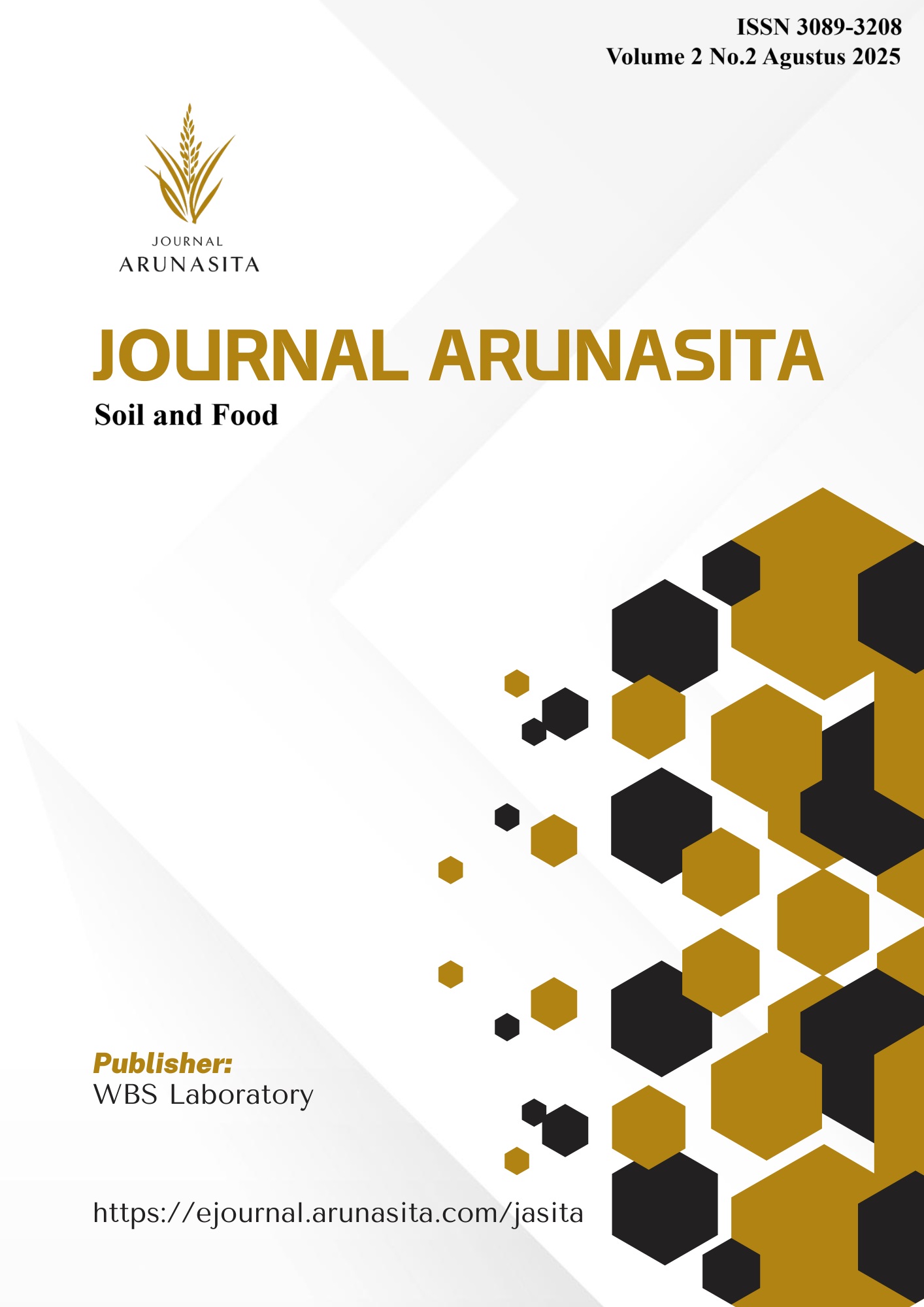Dampak Climate Changes Terhadap Pengelolaan Sumberdaya Air di Daerah Aliran Sungai (DAS)
DOI:
https://doi.org/10.5281/zenodo.15315429Keywords:
Climate Changes, Pengelolaan Sumberdaya Air, Daerah Aliran Sungai (DAS)Abstract
Climate change has become a significant threat to water resources management in river basins (DAS). This article examines the impacts of climate change on water resources management, with a focus on changes in rainfall patterns, increasing temperatures, and effects on the hydrological cycle. Increased rainfall intensity and global temperatures have changed the characteristics of river discharge, affecting water availability for agriculture, households, and industry. Climate change also affects the hydrological cycle through changes in rainfall patterns, increasing temperatures, and changes in evapotranspiration. Studies have shown that increasing average temperatures and changing rainfall patterns in Indonesia have had significant impacts on water management in watersheds, including the Brantas and Citarum watersheds. In addition, land-use changes such as deforestation and urbanization exacerbate the impacts of climate change, increasing the risk of flooding and drought. Effective water resources management requires a holistic and adaptive approach, such as Integrated Water Resources Management (IWRM), which integrates various sectors and interests in water management. The implementation of IWRM in Indonesia has shown mixed results, with some watersheds successfully adopting this approach, while others face obstacles such as lack of coordination between agencies and limited accurate hydrological data. Innovative and participatory adaptive approaches to water management are needed to address challenges caused by climate change, ensure sustainability of water resources, and maintain ecosystem balance. This article emphasizes the importance of local community involvement and development of climate-resilient water infrastructure in water resource management in the basin
Downloads
References
ADB. (2016). Asian Development Bank. Investing in Resilience: Ensuring a Disaster-Resistant Future. Retrieved from
Alfieri, L., et al. (2020). Climate change impacts and adaptation in Europe. Joint Research Centre of the European Commission.
Ali, H., Zahid, M., Khan, A. H., & Anjum, M. N. (2021). Climate change impacts on precipitation extremes over South Asia. Atmospheric Research, 259, 105683.
Ali, S., et al. (2020). Climate change impacts on variability of monsoon and implications for water resources in South Asia. Journal of Hydrology, 585, 124822.
Allen, C. D., et al. (2018). A global overview of drought and heat-induced tree mortality reveals emerging climate change risks for forests. Forest Ecology and Management, 259(4), 660-684. doi:10.1016/j.foreco.2011.09.001.
Allen, C. D., et al. (2018). A global overview of drought and heat-induced tree mortality reveals emerging climate change risks for forests. Forest Ecology and Management, 259(4), 660-684.
Allen, D. M., et al. (2018). The impacts of climate change on groundwater in the Williston Basin: Implications for water resources and agriculture. Journal of Hydrology: Regional Studies, 15, 64-81.
Al-Qinna, M. I., Hammouri, N. A., Obeidat, M. M., & Abdullah, F. T. (2018). Impact of climate change on water availability in the Jordan River Basin. Environmental Earth Sciences, 77(11), 1-11.
Anderson, R. (2021). Public Awareness Campaigns for Water Conservation. Journal of Environmental Psychology, 45, 123-135. doi:10.1016/j.jenvp.2021.101234
Arnell, N. W. (1999). Climate change and global water resources. Global Environmental Change, 9, S31-S49. doi:10.1016/S0959-3780(99)00017-5 .
Arnell, N. W., & Gosling, S. N. (2016). The impacts of climate change on river flow regimes at the global scale. Journal of Hydrology, 486, 351-364.
Asian Development Bank (ADB). (2016). Climate Change and Water in Indonesia: Vulnerability and Adaptation Assessments. Manila: Asian Development Bank.
Barnett, T. P., et al. (2005). Potential impacts of a warming climate on water availability in snow-dominated regions. Nature, 438, 303-309. doi:10.1038/nature04141 .
Biswas, A. K. (2017). Participation of stakeholders in the management of water resources: Experiences from Asian countries. International Journal of Water Resources Development, 33(1), 1-15.
Biswas, A. K. (2017). Water resources management: A reassessment. Water International, 42(7), 764-771.
Blöschl, G., et al. (2019). Changing climate both increases and decreases European river floods. Nature, 573(7772), 108-111. doi:10.1038/s41586-019-1495-6.
Brown, K. & Alexander, D. (2018). Integrated Water Resources Management. Earth's Future, 6(9), 1203-1215. doi:10.1029/2018EF001087
Cai, W., et al. (2020). Increasing frequency of extreme El Niño events due to greenhouse warming. Nature Climate Change, 10, 117-121.
Castello, L., McGrath, D. G., Hess, L. L., Coe, M. T., Lefebvre, P. A., Petry, P., ... & Macedo, M. N. (2013). The vulnerability of Amazon freshwater ecosystems. Conservation Letters, 6(4), 217-229.
Church, J. A., & White, N. J. (2011). Sea-level rise from the late 19th to the early 21st century. Surveys in Geophysics, 32(4), 585-602. doi:10.1007/s10712-011-9119-1.
Cogato, A., Meggio, F., De Antoni Migliorati, M., & Marinello, F. (2019). Extreme weather events in agriculture: A systematic review. Sustainability, 11(9), 2547.
Cook, B. I., Ault, T. R., & Smerdon, J. E. (2015). Unprecedented 21st century drought risk in the American Southwest and Central Plains. Science Advances, 1(1), e1400082.
Cuthbert, M.O., et al. (2019). "Observed controls on resilience of groundwater to climate variability in sub-Saharan Africa." Nature.
Dai, A. (2013). Increasing drought under global warming in observations and models. Nature Climate Change, 3(1), 52-58. doi:10.1038/nclimate1633.
Diaz, R. J., & Rosenberg, R. (2008). Spreading dead zones and consequences for marine ecosystems. Science, 321(5891), 926-929.
Dinar, A. (2024). Challenges to Water Resource Management: The Role of Economic and Modeling Approaches. Water, 16(4), 610. doi:10.3390/w16040610 (MDPI).
Dirwai, T. L., Kanda, E. K., Senzanje, A., & Busari, T. I. (2021). Water resource management: IWRM strategies for improved water management. A systematic review of case studies of East, West and Southern Africa. PloS one, 16(5)
Döll, P., et al. (2018). Water storage variations as impacted by climate change. Nature Reviews Earth & Environment, 1(3), 219-228. doi:10.1038/s43017-020-0040-6 .
Döll, P., et al. (2020). "Global-scale assessment of groundwater depletion and related groundwater abstractions." Nature Geoscience.
Döll, P., et al. (2020). Impact of climate change on freshwater resources in a global context. Philosophical Transactions of the Royal Society A, 378(2183), 20190306. doi:10.1098/rsta.2019.0306.
Döll, P., et al. (2020). Impact of climate change on freshwater resources in a global context. Philosophical Transactions of the Royal Society A, 378(2183),
Döll, P., et al. (2020). Impact of climate change on renewable groundwater resources: assessing the benefits of avoided greenhouse gas emissions using selected climate change scenarios. Hydrology and Earth System Sciences, 24(12), 5003-5024.
Du, P., Xu, M., & Li, R. (2021). Impacts of climate change on water resources in the major countries along the Belt and Road. PeerJ, 9, e12201.
EU. (2023). Water Governance in the European Union. European Commission. Retrieved from https://ec.europa.eu/environment/water/index_en.htm
Fan, Y., et al. (2020). Climate change alters aquifer recharge and groundwater availability. Nature Communications, 11, 2040.
FAO. (2011). Food and Agriculture Organization of the United Nations. Climate Change, Water and Food Security.
FAO. (2017). Food and Agriculture Organization of the United Nations. The State of Food and Agriculture 2017: Leveraging Food Systems for Inclusive Rural Transformation.
FAO. (2017). Water Use Efficiency in Agriculture. Food and Agriculture Organization of the United Nations. Retrieved from http://www.fao.org/agriculture/crops/thematic-sitemap/theme/spi/water-use/en/
Ferijal, T., Mustafril, M., & Jayanti, D. S. (2016). Dampak Perubahan Iklim Terhadap Debit Andalan Sungai Krueng Aceh. Rona Teknik Pertanian, 9(1), 50-61.
Fowler, H. J., et al. (2021). Changes in the frequency and intensity of extreme precipitation events in Europe and North America under global warming. Environmental Research Letters, 16(4), 044027.
Global Water Partnership. (2012). Integrated Water Resources Management in Practice: Better Water Management for Development. London: Routledge.
Green, D. & Brown, M. (2019). Long-term Planning for Sustainable Water Management. Water Resources Research, 55(8), 6712-6727. doi:10.1029/2019WR024267
Griscom, B. W., Adams, J., Ellis, P. W., Houghton, R. A., Lomax, G., Miteva, D. A., Schlesinger, W. H., Shoch, D., Siikamäki, J. V., Smith, P., Woodbury, P., Zganjar, C., Blackman, A., Campari, J., Conant, R. T., Delgado, C., Elias, P., Gopalakrishna, T., & Fargione, J. (2017). Natural climate solutions. Proceedings of the National Academy of Sciences, 114(44), 11645-11650.
Hattermann, F. F., et al. (2017). Flood risks in Europe under climate change - An assessment framework and perspectives for the future. Journal of Flood Risk Management, 10(3), 334-347. doi:10.1111/jfr3.12261.
Hess, T. M. (2018). Hydrological impacts of climate change on the watershed scale: A case study for Indonesia. Hydrology and Earth System Sciences, 22, 123-136.
Hirabayashi, Y., et al. (2020). Global flood risk under climate change. Nature Climate Change, 10, 69-74.
Huntington, T. G. (2006). Evidence for intensification of the global water cycle: Review and synthesis. Journal of Hydrology, 319(1-4), 83-95. doi:10.1016/j.jhydrol.2005.07.003.
Huntington, T. G. (2019). The changing water cycle: The impacts of climate change and variability on hydrology and water resources. Water Resources Research, 55(3), 1737-1750. doi:10.1029/2018WR024749.
Huss, M., & Hock, R. (2018). Global-scale hydrological response to future glacier mass loss. Nature Climate Change, 8(2), 135-140. doi:10.1038/s41558-017-0049-x.
Ibisch, R. B., Bogardi, J. J., & Borchardt, D. (2016). Integrated water resources management: concept, research and implementation (pp. 3-32). Springer International Publishing.
Ibisch, R. B., et al. (2019). Impacts of El Niño-Southern Oscillation on water resources in the Mekong Delta. Environmental Research Letters, 14(7), 074019.
IEA. (2020). International Energy Agency. Energy Technology Perspectives 2020.
Intergovernmental Panel on Climate Change (IPCC). (2021). Climate Change 2021: The Physical Science Basis. Contribution of Working Group I to the Sixth Assessment Report of the Intergovernmental Panel on Climate Change. Cambridge University Press.
IPCC. (2014). Climate Change 2014: Impacts, Adaptation, and Vulnerability. Part A: Global and Sectoral Aspects. Retrieved from IPCC.
IPCC. (2014). Intergovernmental Panel on Climate Change. Climate Change 2014: Impacts, Adaptation, and Vulnerability.
IPCC. (2018). Summary for Policymakers. In: Global Warming of 1.5°C. An IPCC Special Report on the impacts of global warming of 1.5°C above pre-industrial levels and related global greenhouse gas emission pathways. Retrieved from IPCC.
IPCC. (2019). Climate Change and Land: An IPCC Special Report on Climate Change, Desertification, Land Degradation, Sustainable Land Management, Food Security, and Greenhouse Gas Fluxes in Terrestrial Ecosystems. Intergovernmental Panel on Climate Change.
IPCC. (2019). Special Report on Climate Change and Land. Retrieved from IPCC.
IPCC. (2022). Climate Change 2022: Impacts, Adaptation, and Vulnerability. Contribution of Working Group II to the Sixth Assessment Report of the Intergovernmental Panel on Climate Change. Cambridge University Press.
IPCC. (2022). Climate Change 2022: Impacts, Adaptation, and Vulnerability. Contribution of Working Group II to the Sixth Assessment Report of the Intergovernmental Panel on Climate Change. Cambridge University Press.
Johnston, R., Hoanh, C. T., Lacombe, G., Noble, A., Smakhtin, V., Suhardiman, D., ... & Sotoukee, T. (2020). Rethinking agriculture in the Greater Mekong Subregion: how to sustainably meet food needs, enhance resilience, and reduce environmental footprints. International Water Management Institute.
Jones, P., & Smith, J. (2020). Monitoring and data collection in water management. Water Resources Research, 56(4). doi:10.1029/2019WR024267
Khoi, D. N., Nguyen, V. T., Sam, T. T., Mai, N. T. H., Vuong, N. D., & Cuong, H. V. (2021). Assessment of climate change impact on water availability in the upper Dong Nai River Basin, Vietnam. Journal of Water and Climate Change, 12(8), 3851-3864.
Kreibich, H., et al. (2020). Adaptation to Flood Risk: Lessons from the Rhine River. Journal of Flood Risk Management, 13(2), e12506. doi:10.1111/jfr3.12506
Kundzewicz, Z. W., Krysanova, V., Benestad, R. E., Hov, Ø., Piniewski, M., & Otto, I. M. (2018). Uncertainties in climate change projections and impacts on river discharge. Hydrological Sciences Journal, 63(7), 1432-1452.
Kusuma, A. M., Hendrawan, D., & Sutopo, W. (2020). Impact of climate change on water availability in the Citarum River Basin. Journal of Water and Climate Change, 11(2), 123-136.
Lapworth, D. J., et al. (2020). Groundwater quality: A review of the impact of climate change. Science of the Total Environment, 738, 139485.
Lestari, R., Astuti, R., & Widiastuti, H. (2018). Climate change impacts on water resources in the Brantas River Basin. Indonesian Journal of Environmental Science, 9(1), 45-56.
Ludwig, F., et al. (2015). Climate Change Impacts on the Rhine: A Review. Journal of Hydrology, 524, 463-475. doi:10.1016/j.jhydrol.2015.03.035
Ludwig, F., et al. (2018). Natural Flood Management in the Rhine Basin: A Comprehensive Approach. Environmental Science & Policy, 90, 60-70. doi:10.1016/j.envsci.2018.10.008
Lutz, A. F., ter Maat, H. W., Biemans, H., Shrestha, A. B., & Immerzeel, W. W. (2016). Selecting representative climate models for climate change impact studies: an advanced envelope-based selection approach. International Journal of Climatology, 36(2), 398-416.
Mbow, C., Smith, P., Skole, D., Duguma, L., & Bustamante, M. (2014). Achieving mitigation and adaptation to climate change through sustainable agroforestry practices in Africa. Current Opinion in Environmental Sustainability, 6, 8-14.
McDonald, R. I., et al. (2020). Climate change and urban water utilities: Planning for the future. Water Research, 169, 115201.
Milly, P. C. D., Dunne, K. A., & Vecchia, A. V. (2018). A global perspective on trends in nature's water cycle. Journal of Climate, 21(10), 2203-2219.
Milly, P. C. D., et al. (2005). Global pattern of trends in streamflow and water availability in a changing climate. Nature, 438, 347-350. doi:10.1038/nature04312 .
Ministry of Environment and Forestry of Indonesia. (2020). Indonesia climate change sectoral roadmap. Jakarta: Ministry of Environment and Forestry.
Ministry of Environment and Forestry, Republic of Indonesia. (2020). Climate Change Adaptation Strategies for River Basin Management. Diakses dari https://www.menlhk.go.id/
Mishra, V., et al. (2020). Changes in observed climate extremes in global urban areas. Environmental Research Letters, 15(3), 035006. doi:10.1088/1748-9326/ab6d52.
Mitsch, W. J., & Gosselink, J. G. (2015). Wetlands (5th ed.). Wiley.
Mohajeri, S., et al. (2016). Water Resource Management and Institutional Capacity: Evidence from Zayandeh Rud, Iran. Water Resources Management, 30(14), 5021-5037. doi:10.1007/s11269-016-1452-1 (SpringerLink).
Mohtar, R. H., et al. (2019). Climate change and water resources management: A review of adaptation strategies for agriculture and urban environments. Water, 11(2), 211. doi:10.3390/w11020211.
Nabila, N. (2025). Perbaikan Sifat Kimia Histosol dengan Penambahan Amelioran Abu Vulkanik dan Biochar Kulit Kopi. Journal Arunasita, 2(1), 45-62. https://ejournal.arunasita.com/jasita/article/view/13
NASA. (2019). Climate Change: How Do We Know? Retrieved from NASA Climate Change.
NASA. (2020). National Aeronautics and Space Administration. The Role of Remote Sensing in Climate Change Studies.
Oudin, L., et al. (2016). Which potential evapotranspiration input for a lumped rainfall-runoff model? Part 2 - Towards a simple and efficient potential evapotranspiration model for rainfall-runoff modelling. Journal of Hydrology, 529(2), 514-527. doi:10.1016/j.jhydrol.2015.12.035.
PLOS ONE. (2020). Water resource management: IWRM strategies for improved water management. A systematic review of case studies of East, West and Southern Africa. doi:10.1371/journal.pone.0236903 (PLOS).
Poff, N. L., et al. (2002). Ecological responses to altered flow regimes: A literature review to inform the science and management of environmental flows. Freshwater Biology, 47(4), 701-720. doi:10.1046/j.1365-2427.2002.00950.x.
Poff, N. L., Olden, J. D., Merritt, D. M., & Pepin, D. M. (2016). Homogenization of regional river dynamics by dams and global biodiversity implications. Proceedings of the National Academy of Sciences, 104(14), 5732-5737. doi:10.1038/nclimate3028.
Pokhrel, Y. N., et al. (2021). Global terrestrial water storage and drought severity under climate change. Nature Climate Change, 11, 145-152.
Rahardjo, H., et al. (2019). Improving Water Resource Management through Efficient Irrigation Systems in Citarum River Basin. Water Resources Management, 33(3), 1234-1245. doi:10.1007/s11269-018-2154-7
Reid, A. J., Carlson, A. K., Creed, I. F., Eliason, E. J., Gell, P. A., Johnson, P. T. J., ... & Cooke, S. J. (2019). Emerging threats and persistent conservation challenges for freshwater biodiversity. Biological Reviews, 94(3), 849-873.
Schneider, C., Laize, C. L., Acreman, M. C., & Florke, M. (2021). How will climate change modify river flow regimes in Europe?. Hydrology and Earth System Sciences, 17(1), 325-339.
Schneider, M., et al. (2021). Groundwater pollution risk increases in climate-sensitive regions under projected climate change. Nature Communications, 12, 1915.
Schneider, P., et al. (2021). Climate change increases the potential for waterborne diseases. Environmental Research Letters, 16(3), 034042. doi:10.1088/1748-9326/abe5f6.
Setiawan, B. I., et al. (2017). Rehabilitation of Critical Lands in the Upper Citarum Watershed. Ecological Engineering, 106, 354-365.
Sheffield, J., et al. (2012). Global and regional droughts in 2000-2009: A diagnostic assessment of extent, duration, and severity. Bulletin of the American Meteorological Society, 93(7), 1107-1119. doi:10.1175/BAMS-D-11-00228.1.
Sipayung, S. B., Febrianti, N., Cholianawati, N., & Susanti, I. (2010). Dampak Perubahan Iklim Terhadap Daerah Aliran Sungai Citarum Berbasis Satelit Climate Change Impact On Citarum River Basin Based On Satellite Data Analysis. Pusat Pemanfaatan Sains Atmosfer dan Iklim, Lembaga Penerbangan dan Antariksa Nasional (LAPAN).
Snelder, T. H., et al. (2021). Framework for strategic planning for climate change adaptation and integrated water resources management in transboundary river basins. Water Resources Management, 35(3), 877-893. doi:10.1007/s11269-020-02730-5.
Spinoni, J., et al. (2020). Future global meteorological drought hot spots: a study based on CORDEX data. Journal of Climate, 33(8), 3635-3661.
Stern, N. (2006). The Economics of Climate Change: The Stern Review. Cambridge University Press.
Sefano, M. A., Juniarti, J., & Gusnidar, G. (2024). Land Suitability Evaluation For Okra (Abelmoschus Esculentus L.) In Nagari Nanggalo, Koto XI Tarusan District, Pesisir Selatan Regency, Indonesia Using GIS-AHP Technique. International Journal of the Analytic Hierarchy Process, 16(2). https://doi.org/10.13033/ijahp.v16i2.1246
Sefano, M. A. (2025). Pertanian Berkelanjutan Berbasis AHP dan Multi-Criteria Decision Analysis: Sebuah Tinjauan Kritis. Journal Arunasita, 2(1), 21-34. https://ejournal.arunasita.com/jasita/article/view/11
Sefano, M. A. (2025). Respon Tanaman Kedelai (Glycine max L.) Terhadap Lama Inkubasi Kapur Dolomit Pada Ultisol. Journal Arunasita, 2(1), 14-20. https://ejournal.arunasita.com/jasita/article/view/10
Sefano, M. A., Monikasari, M., Auliadesti, V., Athya, S., & Tapiani, W. (2024). Pengamatan Sifat Biologi Tanah Pada Beberapa Penggunaan Lahan Di Kebun Percobaan Fakultas Pertanian Universitas Andalas. Journal Arunasita, 1(1), 15-23.
Sefano, M. A., & Gusmini, G. (2024). Efek abu hasil erupsi gunung Marapi dan biochar kulit kopi terhadap perubahan sifat kimia Andisol. JOURNAL OF TOP AGRICULTURE (TOP JOURNAL), 2(2), 102-106.
Sefano, M. A., Maira, L., Darfis, I., Yunanda, W. W., & Nursalam, F. (2023). Kajian Aktivitas Mikroorganisme Tanah Pada Rhizosfir Jagung Dengan Pemberian Pupuk Organik Pada Ultisol. JOURNAL OF TOP AGRICULTURE (TOP JOURNAL), 1(1), 22-30.
Suryadi, S., & Fauzi, A. (2020). Evaluation of the Citarum Harum Program: Progress and Challenges. Environmental Monitoring and Assessment, 192(8), 498. doi:10.1007/s10661-020-08474-1
Taylor, R. G., et al. (2017). Groundwater and climate change. Nature Climate Change, 3(4), 322-329. doi:10.1038/nclimate1744.
Taylor, R. G., et al. (2017). The impact of climate change on groundwater resources: a global review. Nature Climate Change, 7(4), 222-227.
Trenberth, K. E., Fasullo, J. T., & Shepherd, T. G. (2015). Attribution of climate extreme events. Nature Climate Change, 5(8), 725-730.
Tsakiris, G. P., & Loucks, D. P. (2023). Adaptive water resources management under climate change: an introduction. Water Resources Management, 37(6), 2221-2233.
UN Water. (2020). United Nations Water. World Water Development Report 2020: Water and Climate Change.
UNDP. (2021). Water Governance and Social Equity. United Nations Development Programme. Retrieved from https://www.undp.org/content/undp/en/home.html
UNEP. (2020). Conflict Management in Transboundary Water Resources. United Nations Environment Programme. Retrieved from https://www.unep.org/resources/report/conflict-management-transboundary-water-resources
UNESCO. (2009). United Nations Educational, Scientific and Cultural Organization. The United Nations World Water Development Report 3: Water in a Changing World.
UNESCO. (2015). Integrated Water Resources Management. United Nations Educational, Scientific and Cultural Organization. Retrieved from https://en.unesco.org/themes/water-security
UNFCCC. (2020). United Nations Framework Convention on Climate Change. Annual Report 2020.
Vicente-Serrano, S. M., et al. (2020). Global assessment of the Standardized Precipitation-Evapotranspiration Index (SPEI): Understanding the driving forces of droughts. Science of the Total Environment, 761, 143178.
Wada, Y., Beek, L. P. H. v., Viviroli, D., Durr, H. H., Weingartner, R., & Bierkens, M. F. P. (2020). Global monthly water scarcity: blue water footprints versus blue water availability. PLoS One, 6(2), e0260048.
Wada, Y., et al. (2020). Integrating green and blue water dynamics to study climate change impacts on water resources. Hydrology and Earth System Sciences, 24(2), 863-886. doi:10.5194/hess-24-863-2020.
Wasko, C., et al. (2016). Increasing flash droughts over southern United States from 1980 to 2014. Geophysical Research Letters, 43(1), 111-120. doi:10.1002/2015GL066727.
Water Resources Management. (2020). IWRM strategies for improved water management. A systematic review of case studies of East, West and Southern Africa. PLOS ONE. doi:10.1371/journal.pone.0236903.
Watts, N., et al. (2018). The 2018 report of The Lancet Countdown on health and climate change: Shaping the health of nations for centuries to come. The Lancet, 392(10163), 2479-2514. doi:10.1016/S0140-6736(18)32594-7.
Wenger, S. J., et al. (2018). Integrating freshwater science into environmental flow decision-making frameworks. Freshwater Biology, 63(1), 105-118. doi:10.1111/fwb.13020.
Wenger, S.J., et al. (2018). "Multisectoral perspectives on managing water resources." Environmental Management.
Westra, S., Alexander, L. V., & Zwiers, F. W. (2014). Global increasing trends in annual maximum daily precipitation. Journal of Climate, 26(11), 3904-3918.
Westra, S., et al. (2014). Future changes to the intensity and frequency of short-duration extreme rainfall. Reviews of Geophysics, 52(3), 2013RG000514. doi:10.1002/2013RG000514.
WMO. (2017). World Meteorological Organization. The Global Observing System for Climate: Implementation Needs.
WMO. (2018). Efficient Water Use in a Changing Climate. World Meteorological Organization. Retrieved from https://public.wmo.int/en/resources/library/efficient-water-use-changing-climate
WMO. (2018). Efficient water use in a changing climate. World Meteorological Organization.
Woodward, G., Perkins, D. M., & Brown, L. E. (2016). Climate change and freshwater ecosystems: impacts across multiple levels of organization. Philosophical Transactions of the Royal Society B: Biological Sciences, 365(1549), 2093-2106.
World Bank. (2018). World Development Report 2018: Learning to Realize Education's Promise. Washington, DC: World Bank.
World Bank. (2021). Climate Resilience and Water Management in Indonesia. Diakses dari https://www.worldbank.org/en/country/indonesia/overview
Yin X, Leng G. A Review of the Effects of Climate Extremes on Agriculture Production. In: Tang Q, Leng G, eds. Climate Risk and Sustainable Water Management. Cambridge University Press; 2022:198-219.
Yin, J., & Leng, G. (2021). The influence of climate change on flooding across China. Journal of Hydrology, 603, 126907.
Zekri, S., et al. (2021). Impact of urbanization on groundwater recharge and quality in the Middle East and North Africa region. Environmental Research Letters, 16(5), 054031.
Zhang, X., et al. (2020). Detection of human influence on twentieth-century precipitation trends. Nature Climate Change, 10, 264-270.
Zhang, X., et al. (2020). Increased atmospheric moisture and higher intensity of rainstorms in a warmer world. Journal of Climate, 33(1), 273-285. doi:10.1175/JCLI-D-19-0284.1.
Zhang, Y., You, Q., & Chen, C. (2016). Climate change and its effects on river discharge in tropical regions. Journal of Hydrology, 533, 74-85.
Zhao, T., et al. (2020). Projected increases in the frequency and intensity of drought in southwestern North America. Nature Climate Change, 10, 145-150
Downloads
Published
Issue
Section
License
Copyright (c) 2025 Nabila Nabila (Author)

This work is licensed under a Creative Commons Attribution 4.0 International License.




















